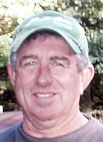
Keith Stevens farms with his brother-in-law, Les Hopkins, on a 170-acre farm in Polk County near Bolivar, Mo. Keith and Les both have jobs off the farm.
The farm belonged to Keith’s father-in-law, Ted Hopkins. Keith said, “He passed away in 2003, so we kind of took over the operation at that point.” Keith and his wife have lived on the farm since 1984.
Before his father-in-law passed away, Keith said he gave him some advice. “He told us to get connected with the USDA and NRCS (Natural Resources Conservation Service). That’s probably the best advice I’ve ever had, because it’s got us to where we are now.”
They now have 50 head of breeding cattle. Keith said, “The cows are mixed breeds. We’ve got Charolais and Braunvieh and a little bit of Hereford base.”
Keith explained, “Several of the Charolais are offspring from the original herd. My father-in-law had Charolais and Herefords at that time. We liked the Charolais breed. They’re a big cow and can handle calving. We bred Braunvieh bulls for a couple of years trying to get a little more muscle and a little heavier body. But with the markets like they are, they dock those colored cattle so bad that we finally switched to Black Angus bulls this past year. Our first calves will be coming soon.”
Keith and Les raise their own replacement heifers. Keith said, “Every two or three years we will change our bulls, depending on which calves we keep.”
Keith’s father-in-law was involved in the Soil and Water and was on the board for several years. Now Keith is on the board. He said, “He always told us that when he was gone we needed to get involved with Soil and Water and they would help along the way. In 2003, we did.”
The men talked with the local agents in the USDA and NRCS. Keith said, “One program was rotational grazing. Working with them on cost share and whatever, we’ve now got seven water tanks, two miles of water line and seven or eight miles of the hard electric fence.” Keith went on to say, “It’s been a great thing. We’ve worked with them on the nutrient programs and learned a lot and made improvements. This farm used to only support about 30 head of breeding cattle the way we used to farm it. We’ve increased to 50 head of adult cows now with rotational grazing.”
Keith and Les grow their own hay. Keith said, “Since we do the rotational grazing, we cut different fields each year to try to alter where you’re taking the hay off because you lose so many nutrients in that process.”
Keith continued, “Polk County has been very, very dry. A lot of the grass is gone. Generally at this time of year, we go into a stockpile situation where we put a lot of fertilizer on the fescue and we pick certain fields and about this time of year (September), we stay off of them for the year.”
The new rotational techniques have been a real learning process for Keith and he is very impressed with the results. He said, “To go back and graze those hayfields and graze somewhere else, the following year you see a total difference in the hayfield because you’ve put organic matter back and added something back to it other than just fertilizer.”







